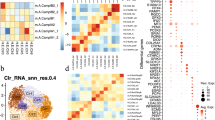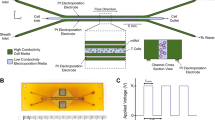Abstract
For alveolar type I cells, phenotype plasticity and physiology other than gas exchange await further clarification due to in vitro study difficulties in isolating and maintaining type I cells in primary culture. Using an established in vitro model of human fetal type II cells, in which the type II phenotype is induced and maintained by adding hormones, we assessed for transdifferentiation in culture toward a type I-like cell with hormone removal for up to 144 h, followed by electron microscopy, permeability studies, and RNA and protein analysis. Hormone withdrawal resulted in diminished type II cell characteristics, including decreased microvilli, lamellar bodies, and type II cell marker RNA and protein. There was a simultaneous increase in type I characteristics, including increased epithelial cell barrier function indicative of a tight monolayer and increased type I cell marker RNA and protein. Our results indicate that hormone removal from cultured human fetal type II cells results in transdifferentiation toward a type I-like cell. This model will be useful for continued in vitro studies of human fetal alveolar epithelial cell differentiation and phenotype plasticity.
Similar content being viewed by others
Log in or create a free account to read this content
Gain free access to this article, as well as selected content from this journal and more on nature.com
or
Abbreviations
- Cav-1:
-
caveolin-1
- DCI:
-
dexamethasone, cAMP, and isobutylmethylxanthine
- GAPDH:
-
glyceraldehyde-3-phosphate dehydrogenase
- PAI-1:
-
plasminogen activator inhibitor-1
- PGC:
-
pepsinogen C
- SEM:
-
scanning electron microscopy
- SP-A, SP-B, SP-C:
-
surfactant proteins A, B, C
- TEM:
-
transmission electron microscopy
- TER:
-
transepithelial resistance
- ZO-1:
-
zonula occludens-1
References
Mallampalli RK, Acarregui MJ, Snyder JM 1997 Differentiation of the alveolar epithelium in the fetal lung. In: McDonald JA (ed) Lung Growth and Development. Marcel Dekker, New York, pp 119–162
Foster C, Aktar A, Kopf D, Zhang P, Guttentag S 2004 Pepsinogen C: a type 2 cell-specific protease. Am J Physiol Lung Cell Mol Physiol 286: L382–L387
Borok Z, Hami A, Danto SI, Zabski SM, Crandall ED 1995 Rat serum inhibits progression of alveolar epithelial cells toward the type I cell phenotype in vitro. Am J Respir Cell Mol Biol 12: 50–55
Williams MC 2003 Alveolar type i cells: molecular phenotype and development. Annu Rev Physiol 65: 669–695
Chen J, Chen Z, Narasaraju T, Jin N, Liu L 2004 Isolation of highly pure alveolar epithelial type I and type II cells from rat lungs. Lab Invest 84: 727–735
Dobbs LG, Gonzalez R, Matthay MA, Carter EP, Allen L, Verkman AS 1998 Highly water-permeable type I alveolar epithelial cells confer high water permeability between the airspace and vasculature in rat lung. Proc Natl Acad Sci U S A 95: 2991–2996
Mason RJ, Dobbs LG 1980 Synthesis of phosphatidylcholine and phosphatidylglycerol by alveolar type II cells in primary culture. J Biol Chem 255: 5101–5107
Chen SP, Zhou B, Willis BC, Sandoval AJ, Liebler JM, Kim KJ, Ann DK, Crandall ED, Borok Z 2005 Effects of transdifferentiation and EGF on claudin isoform expression in alveolar epithelial cells. J Appl Physiol 98: 322–328
Dobbs LG, Williams MC, Gonzalez R 1988 Monoclonal antibodies specific to apical surfaces of rat alveolar type I cells bind to surfaces of cultured, but not freshly isolated, type II cells. Biochim Biophys Acta 970: 146–156
Fuchs S, Hollins AJ, Laue M, Schaefer UF, Roemer K, Gumbleton M, Lehr CM 2003 Differentiation of human alveolar epithelial cells in primary culture: morphological characterization and synthesis of caveolin-1 and surfactant protein-C. Cell Tissue Res 311: 31–45
Evans MJ, Cabral LJ, Stephens RJ, Freeman G 1975 Transformation of alveolar type 2 cells to type 1 cells following exposure to NO2. Exp Mol Pathol 22: 142–150
Gonzales LW, Angampalli S, Guttentag SH, Beers MF, Feinstein SI, Matlapudi A, Ballard PL 2001 Maintenance of differentiated function of the surfactant system in human fetal lung type II cells cultured on plastic. Pediatr Pathol Mol Med 20: 387–412
Gonzales LW, Guttentag SH, Wade KC, Postle AD, Ballard PL 2002 Differentiation of human pulmonary type II cells in vitro by glucocorticoid plus cyclic AMP. Am J Physiol Lung Cell Mol Physiol 283: L940–L951
Foster CD, Zhang PX, Gonzales LW, Guttentag SH 2003 In vitro surfactant protein B deficiency inhibits lamellar body formation. Am J Respir Cell Mol Biol 29: 259–266
Wang F, Daugherty B, Keise LL, Wei Z, Foley JP, Savani RC, Koval M 2003 Heterogeneity of claudin expression by alveolar epithelial cells. Am J Respir Cell Mol Biol 29: 62–70
Daugherty BL, Mateescu M, Patel AS, Wade K, Kimura S, Gonzales LW, Guttentag S, Ballard PL, Koval M 2004 Developmental regulation of claudin localization by fetal alveolar epithelial cells. Am J Physiol Lung Cell Mol Physiol 287: L1266–L1273
Cheek JM, Evans MJ, Crandall ED 1989 Type I cell-like morphology in tight alveolar epithelial monolayers. Exp Cell Res 184: 375–387
Qiao R, Zhou B, Liebler JM, Li X, Crandall ED, Borok Z 2003 Identification of three genes of known function expressed by alveolar epithelial type I cells. Am J Respir Cell Mol Biol 29: 98–105
Adamson IY, Bowden DH 1975 Derivation of type 1 epithelium from type 2 cells in the developing rat lung. Lab Invest 32: 736–745
Chen J, Chen Z, Chintagari NR, Bhaskaran M, Jin N, Narasaraju T, Liu L 2006 Alveolar type I cells protect rat lung epithelium from oxidative injury. J Physiol 572: 625–638
Gonzalez R, Yang YH, Griffin C, Allen L, Tigue Z, Dobbs L 2005 Freshly isolated rat alveolar type I cells, type II cells, and cultured type II cells have distinct molecular phenotypes. Am J Physiol Lung Cell Mol Physiol 288: L179–L189
Kemp PJ, Kim KJ 2004 Spectrum of ion channels in alveolar epithelial cells: implications for alveolar fluid balance. Am J Physiol Lung Cell Mol Physiol 287: L460–L464
Matthay MA, Folkesson HG, Verkman AS 1996 Salt and water transport across alveolar and distal airway epithelia in the adult lung. Am J Physiol 270: L487–L503
Cavanaugh KJ, Cohen TS, Margulies SS 2006 Stretch increases alveolar epithelial permeability to uncharged micromolecules. Am J Physiol Cell Physiol 290: C1179–C1188
Bourke S, Mason HS, Borok Z, Kim KJ, Crandall ED, Kemp PJ 2005 Development of a lung slice preparation for recording ion channel activity in alveolar epithelial type I cells. Respir Res 6: 40
Van Itallie CM, Anderson JM 2004 The molecular physiology of tight junction pores. Physiology (Bethesda) 19: 331–338
Borok Z, Hami A, Danto SI, Lubman RL, Kim KJ, Crandall ED 1996 Effects of EGF on alveolar epithelial junctional permeability and active sodium transport. Am J Physiol 270: L559–L565
Everett RS, Vanhook MK, Barozzi N, Toth I, Johnson LG 2006 Specific modulation of airway epithelial tight junctions by apical application of an occludin peptide. Mol Pharmacol 69: 492–500
Newman V, Gonzalez RF, Matthay MA, Dobbs LG 2000 A novel alveolar type I cell-specific biochemical marker of human acute lung injury. Am J Respir Crit Care Med 161: 990–995
Anderson RG 1998 The caveolae membrane system. Annu Rev Biochem 67: 199–225
Kogo H, Fujimoto T 2000 Caveolin-1 isoforms are encoded by distinct mRNAs. Identification Of mouse caveolin-1 mRNA variants caused by alternative transcription initiation and splicing. FEBS Lett 465: 119–123
Ramirez MI, Pollack L, Millien G, Cao YX, Hinds A, Williams MC 2002 The alpha-isoform of caveolin-1 is a marker of vasculogenesis in early lung development. J Histochem Cytochem 50: 33–42
Campbell L, Hollins AJ, Al-Eid A, Newman GR, von Ruhland C, Gumbleton M 1999 Caveolin-1 expression and caveolae biogenesis during cell transdifferentiation in lung alveolar epithelial primary cultures. Biochem Biophys Res Commun 262: 744–751
Barazzone C, Belin D, Piguet PF, Vassalli JD, Sappino AP 1996 Plasminogen activator inhibitor-1 in acute hyperoxic mouse lung injury. J Clin Invest 98: 2666–2673
Eitzman DT, McCoy RD, Zheng X, Fay WP, Shen T, Ginsburg D, Simon RH 1996 Bleomycin-induced pulmonary fibrosis in transgenic mice that either lack or overexpress the murine plasminogen activator inhibitor-1 gene. J Clin Invest 97: 232–237
Cederqvist K, Siren V, Petaja J, Vaheri A, Haglund C, Andersson S 2006 High concentrations of plasminogen activator inhibitor-1 in lungs of preterm infants with respiratory distress syndrome. Pediatrics 117: 1226–1234
Diglio CA, Kikkawa Y 1977 The type II epithelial cells of the lung. IV. Adaption and behavior of isolated type II cells in culture. Lab Invest 37: 622–631
Danto SI, Shannon JM, Borok Z, Zabski SM, Crandall ED 1995 Reversible transdifferentiation of alveolar epithelial cells. Am J Respir Cell Mol Biol 12: 497–502
Flecknoe SJ, Wallace MJ, Harding R, Hooper SB 2002 Determination of alveolar epithelial cell phenotypes in fetal sheep: evidence for the involvement of basal lung expansion. J Physiol 542: 245–253
Borok Z, Danto SI, Lubman RL, Cao Y, Williams MC, Crandall ED 1998 Modulation of t1alpha expression with alveolar epithelial cell phenotype in vitro. Am J Physiol 275: L155–L164
Acknowledgements
The authors thank Sree Angampalli and Ping Wang for type II cell preparation, Michael Koval for assistance with the barrier studies, and Neelimah Shah at the Biomedical Imaging Core of the University of Pennsylvania School of Medicine for the microscopy images. They also thank Michael Beers and Harry Ischiropoulos for editorial assistance.
Author information
Authors and Affiliations
Corresponding author
Additional information
NIH grants HL-077266 (C.D.F.) and HL059959 (S.H.G.) supported the research in this proposal.
Rights and permissions
About this article
Cite this article
Foster, C., Varghese, L., Skalina, R. et al. In Vitro Transdifferentiation of Human Fetal Type II Cells Toward a Type I–like Cell. Pediatr Res 61, 404–409 (2007). https://doi.org/10.1203/pdr.0b013e3180332c6d
Received:
Accepted:
Issue date:
DOI: https://doi.org/10.1203/pdr.0b013e3180332c6d
This article is cited by
-
Human alveolar hydrogels promote morphological and transcriptional differentiation in iPSC-derived alveolar type 2 epithelial cells
Scientific Reports (2023)
-
Perspectives of future lung toxicology studies using human pluripotent stem cells
Archives of Toxicology (2022)
-
Transdifferentiation: a cell and molecular reprogramming process
Cell and Tissue Research (2012)
-
Transient in utero disruption of Cystic Fibrosis Transmembrane Conductance Regulator causes phenotypic changes in Alveolar Type II cells in adult rats
BMC Cell Biology (2009)



